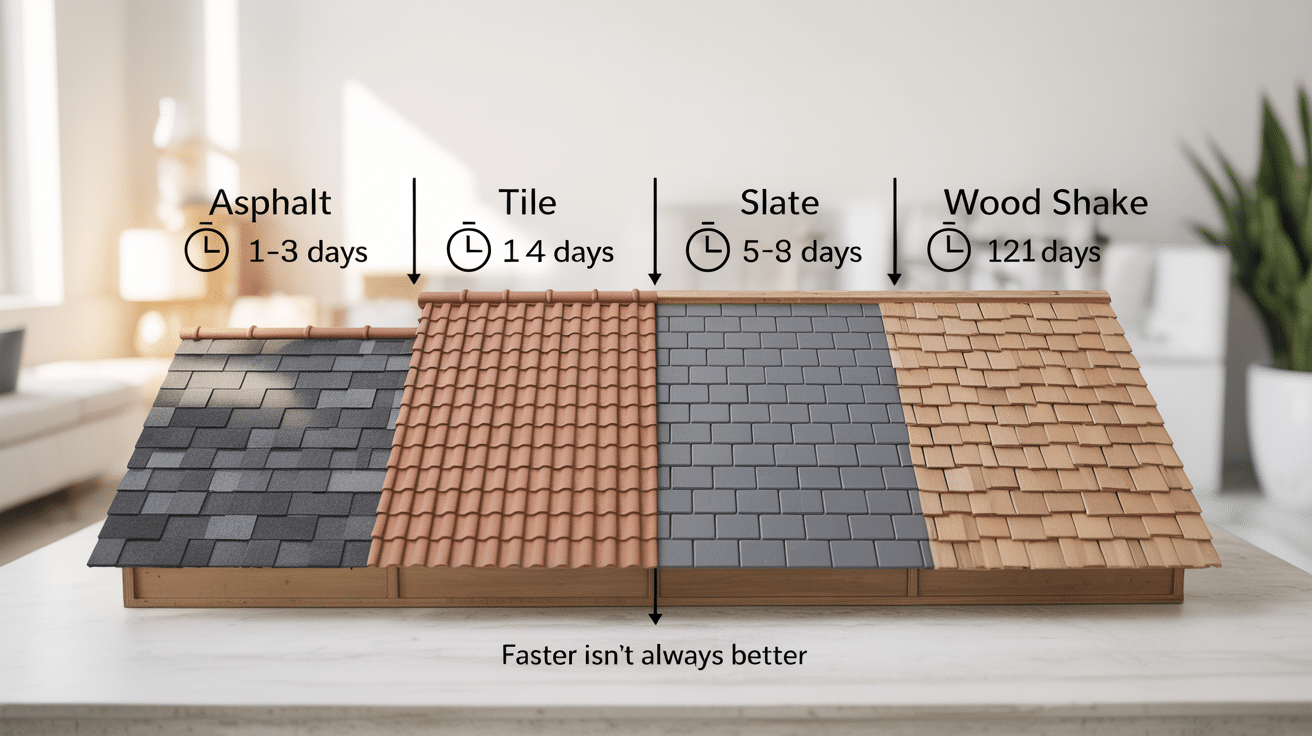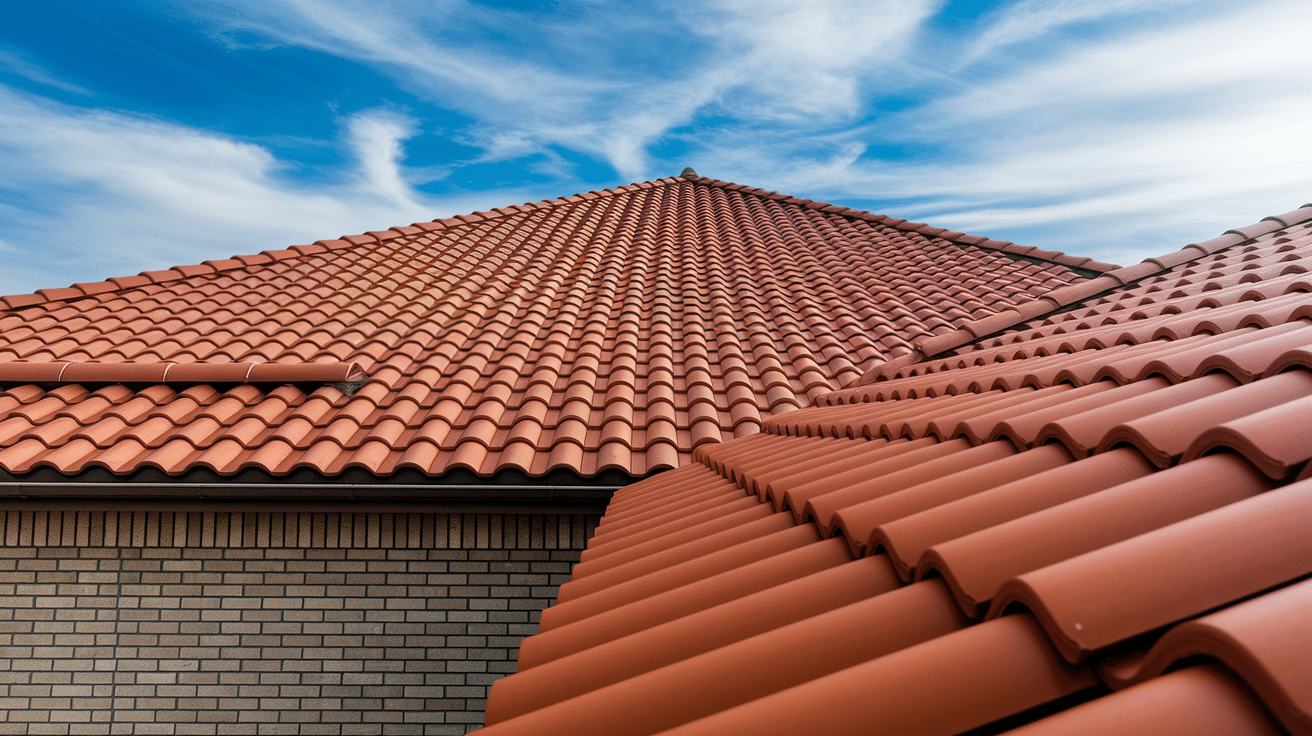Most roof replacements take 1-5 days for installation, but the complete project spans 1-2 weeks from start to finish.
Simple asphalt shingle roofs typically require 1-3 days, while larger homes may take 3-5 days, and premium materials like metal or tile require 5-7 days.
Weather is the biggest factor – rain or wind can halt work entirely. Other variables include roof size, permits, and unexpected damage discovered during tear-off.
The difference between planned and emergency replacements can mean thousands in savings and less stress.
Smart homeowners secure permits early, choose experienced contractors, and schedule during dry weather to avoid costly delays and complications.
What’s the Average Time to Replace a Roof?

Most asphalt shingle roof replacements take 1 to 3 days. This material is common and relatively quick to install.
However, roofs made of slate, tile, or wood shake can take 5 to 14 days, as they require more precision and time.
Some small, simple roofs can be replaced in a single day by an experienced crew. But larger homes or complex roof designs usually take longer.
Keep in mind that faster isn’t always better. A longer timeline often means better attention to detail, which helps prevent costly issues down the road.
Factors Affecting Roof Replacement Time

While some roofs can be replaced in just a day or two, others may take up to two weeks. The timeline depends on a variety of factors that can speed up or slow down the process.
1. Roof Size and Shape Larger roofs naturally take longer to replace. The more square footage, the more materials and labor required. Complex layouts with multiple slopes or levels also add to the timeline.
2. Roofing Material Chosen The roofing material you choose greatly affects the timeline. Asphalt shingles are the fastest, usually done in 1 to 3 days.
Wood shake and metal roofs take around 2 to 5 days, while tile or slate can take 5 to 14 days due to their weight and installation precision.
3. Weather Conditions Rain, wind, or extreme heat can halt or slow progress. Most roofing crews won’t work during poor weather for safety and quality reasons.
4. Tear-Off vs. Overlay Removing the old roof (tear-off) takes more time than laying new shingles over the existing ones. However, tear-offs are often necessary for long-term durability.
5. Structural Repairs If the decking or underlayment is damaged, unexpected repairs will extend the timeline. These issues are sometimes only discovered once the old roof is removed.
6. Crew Size and Experience A large, well-coordinated crew can complete a job faster than a smaller or less experienced team.
7. Permits and Inspections Delays in getting city permits or scheduling inspections can stall the process, especially in areas with strict building codes.
These factors vary from home to home, which is why it’s important to get a detailed estimate and timeline from your contractor before starting the project.
Step-By-Step Breakdown of The Roof Replacement Process

Understanding the roof replacement process helps set realistic expectations for each phase:
Initial Inspection and Estimates (1-2 weeks before work begins) – Contractors assess your roof condition, measure square footage, and identify potential complications. This phase includes finalizing contracts and scheduling.
Securing Permits (3-10 days)- Most municipalities require permits for roof replacement. Processing times vary widely by location, so submit applications early to avoid delays.
Material Delivery (1-2 days before installation) – Materials arrive 24-48 hours before work begins. Delivery timing is crucial; too early and materials sit exposed to weather, too late and crews wait around.
Old Roof Tear-off (Day 1)– Removal of old shingles, underlayment, and flashing typically takes 4-8 hours, depending on roof size and layers of old material.
Repairing Deck if Needed (Day 1-2) – Any damaged or rotten decking gets replaced. This is where unexpected delays often occur if extensive damage is discovered.
Installing Underlayment and Shingles (Day 2-3)– New underlayment goes down first, followed by systematic shingle installation from bottom to top. This represents the bulk of installation time.
Final Inspection and Cleanup (Day 3-4) – Final quality checks, cleanup of debris, and any required municipal inspections complete the project.
Can a Roof Be Replaced in A Day?
Yes, a roof can be replaced in a single day, but it depends on a few key factors. For smaller homes with straightforward layouts and good weather conditions, professional roofing crews often complete the job within 8–12 hours.
However, larger homes, complex roof designs, or issues like wood rot or multiple layers of old roofing can extend the timeline.
What Makes Same-Day Replacement Possible?
- Efficient roofing crew: A large, experienced team can divide tasks and work quickly.
- Simple roof design: One-story homes with minimal angles or features are faster to complete.
- Good weather: Clear skies and dry conditions are essential for safety and progress.
- Pre-planning: Materials and permits must be ready in advance to avoid delays.
When Might It Take Longer?
- Steep or complicated roofs
- Unexpected repairs (like damaged decking)
- Bad weather conditions
- Special materials (like slate or tile)
In summary, many roof replacements can be finished in a day if conditions are right. To know for sure, ask your roofing contractor for a timeline based on your home’s specifics.
Conclusion
Replacing a roof typically takes 1 to 3 days for asphalt shingles and up to 6 to 14 days for materials like slate or tile.
Your timeline can vary depending on roof size, design complexity, weather conditions, material choice, and hidden structural issues.
The key to a successful roof replacement is hiring a skilled contractor, planning for possible delays, and prioritizing quality over speed.
While quick jobs are possible, taking the time to do it right helps prevent costly problems in the long run. A roof is a major investment in your home’s safety and value, so don’t rush it.
Ready to move forward? Gather detailed quotes and timelines from at least three licensed local contractors to ensure your project is well-planned and worry-free.
Frequently Asked Questions
Can I Live in My House While the Roof Is Being Replaced?
Yes, you can stay home during a roof replacement, but expect loud noise and some disruption.
Does Your Home Insurance Cover Roof Replacement?
Yes, home insurance may cover roof replacement if the damage is caused by a covered event like a storm or fire, not wear and tear.
How Do People Pay for A New Roof?
People often pay for a new roof using savings, insurance claims, financing plans, or home improvement loans.


